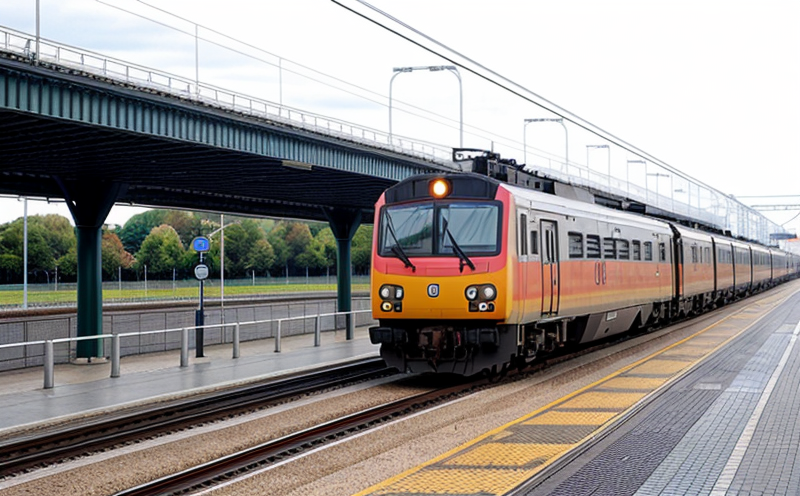EN 15610 Measurement of Railway Trackside Noise Levels
The measurement of railway trackside noise levels is a critical aspect in ensuring compliance with environmental standards and enhancing the overall quality of life around rail transport infrastructure. The European standard CEN EN 15610 provides a comprehensive framework for assessing the sound emissions from railways, focusing specifically on trackside noise measurement. This standard is essential in evaluating the impact of railway operations on surrounding communities and natural habitats.
The process outlined in EN 15610 involves several key steps that are crucial for accurate and reliable measurements. The first step is to define the measurement location by considering factors such as topography, proximity to sensitive areas, and traffic patterns. Once the site has been selected, the next step is to establish a baseline noise level using appropriate instrumentation. This includes the use of sound level meters and octave band analyzers that meet the accuracy requirements specified in EN 15610.
After establishing the baseline, measurements are taken during different operational phases of the railway, including peak traffic periods, off-peak hours, and quiet periods. The standard specifies a set of criteria for acceptable measurement conditions to ensure consistency across different locations and times. It also outlines the procedures for handling transient events such as passing trains or sudden changes in ambient noise.
The data collected during these measurements is then analyzed using statistical methods prescribed by EN 15610. This analysis helps determine compliance with relevant noise limit values, which are typically defined based on environmental impact assessments and local regulations. Compliance is essential for maintaining good relations with neighboring communities and ensuring that railway operations do not exceed acceptable thresholds.
The results of the measurement process should be documented in a comprehensive report that includes all raw data, analysis methods, and conclusions drawn from the measurements. This documentation serves as evidence of compliance with national and international standards, providing assurance to stakeholders that appropriate measures are being taken to mitigate noise pollution.
Implementing EN 15610 ensures not only regulatory compliance but also contributes significantly to environmental protection by promoting quieter rail transport systems. By adhering to this standard, railway operators can reduce their ecological footprint and contribute positively to the sustainability of urban environments.
Applied Standards
The measurement process described in EN 15610 is based on several internationally recognized standards that ensure accuracy and reliability. These include:
- CEN EN ISO 9612: Acoustics—Measurement techniques—Sound level meters, octave band analyzers and related equipment.
- CEN EN ISO 3745: Acoustics—Measurement of sound levels at points on or near the boundaries of rooms.
- IEC 61260: Electroacoustics—Sound level meters and octave band analyzers.
These standards provide the necessary guidelines for selecting appropriate instruments, conducting measurements, and interpreting results. Ensuring compliance with these standards is crucial for obtaining accurate and valid noise measurement data that can be used effectively in regulatory contexts.
Industry Applications
- Railway Noise Mitigation: Railway companies use EN 15610 to assess the effectiveness of noise reduction measures implemented at various stages of project development. This includes testing and validating new materials, designs, or operational strategies aimed at reducing trackside noise.
- Environmental Impact Assessment (EIA): During environmental impact assessments for proposed railway projects, EN 15610 is used to quantify the potential impacts on local communities and natural habitats. This helps stakeholders make informed decisions about project design and implementation.
- Compliance Monitoring: Rail operators regularly perform noise measurements to monitor compliance with national and international standards. This ensures ongoing adherence to environmental regulations and helps maintain a good reputation among regulatory bodies and the public.
In addition to these applications, EN 15610 plays a vital role in promoting sustainable practices within the railway industry by encouraging quieter operations that minimize disturbance to local ecosystems and human populations.
Environmental and Sustainability Contributions
- Sustainable Urban Planning: By reducing noise levels around rail lines, EN 15610 supports sustainable urban planning initiatives that aim to create healthier living environments. Quieter railways contribute to better air quality and overall well-being.
- Biodiversity Preservation: Lower noise emissions from railways can help preserve local biodiversity by minimizing stress on wildlife populations. This aligns with broader sustainability goals aimed at protecting natural habitats.
- Community Well-Being: Noise reduction measures implemented according to EN 15610 enhance community well-being by creating more peaceful living spaces near railway corridors. This improves the quality of life for residents and supports social cohesion.
The implementation of EN 15610 not only addresses immediate environmental concerns but also contributes long-term benefits that support broader sustainability objectives within the rail transport sector.





